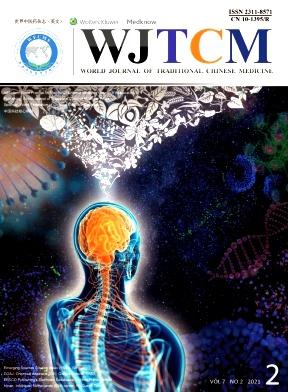网络药理学研究重楼镇痛作用机理
IF 3.2
3区 医学
Q1 INTEGRATIVE & COMPLEMENTARY MEDICINE
引用次数: 7
摘要
目的:利用网络药理学技术和方法,筛选中药重楼对疼痛的治疗靶点,探讨其作用机制。材料与方法:根据化学数据库及相关文献收集重楼药材的化学成分。利用SwissADME对重楼所有化学成分进行潜在有效成分的收集,利用SwissTarget Prediction对其靶标进行预测。与疼痛相关的基因是从GeneCards和在线孟德尔遗传数据库中收集的。将联合基因上传到在线字符串数据库进行分析,并构建PPI网络。利用Cytoscape 3.7.1软件构建“崇楼-活性组分-靶点-痛点”网络,对关键靶蛋白进行基因本体(GO)功能富集分析和京都基因与基因组百科全书(KEGG)通路富集分析。通过分子对接技术将网络中含有最多靶点的前3个活性成分与靶蛋白对接。结果:共筛选出重楼潜在活性化合物9个,潜在靶基因264个,疼痛障碍靶点2385个,药物和疾病共同靶点128个。通过GO富集分析鉴定出131个GO项目,通过KEGG途径富集分析鉴定出23个相关信号通路。分子对接结果表明,pennogenin是PIK3CA、STAT3、丝裂原活化蛋白激酶14和ADORA1的最佳对接配体。结论:初步揭示重楼可能通过多靶点、多生物学过程和多疼痛相关信号通路治疗疼痛,为后续实验研究提供参考。本文章由计算机程序翻译,如有差异,请以英文原文为准。
Mechanism research of chonglou as a pain killer by network pharmacology
Objective: The objective of this study is to screen the therapeutic targets of pain of traditional Chinese medicine Chonglou and explore the relevant mechanism by network pharmacology techniques and methods. Materials and Methods: The chemical components of Chonglou were collected according to chemistry database and related literature. SwissADME was used to collect the potential active ingredients from all the chemical components of Chonglou and SwissTarget Prediction was utilized to predict their targets. The genes related to pain were collected from GeneCards and Online Mendelian Inheritance in Man databases. Joint genes were uploaded to the online string database for the analysis and the PPI network was constructed. The “Chonglou-active component-target-pain” network was constructed by Cytoscape 3.7.1 software, Gene Ontology (GO) functional enrichment analysis and Kyoto Encyclopedia of Genes and Genomes (KEGG) pathway enrichment analysis were performed for key target proteins. The top three active components with most targets in the network were docked with the target proteins by the molecular docking technique. Results: A total of nine potential active compounds of Chonglou, 264 potential target genes, 2385 targets of pain disorder, and 128 common targets for drug and disease were screened. One hundred and thirty-one GO items were identified by the GO enrichment analysis, and 23 related signaling pathways were identified by the KEGG pathway enrichment analysis. Molecular-docking results show that pennogenin is the optimal butt ligand of PIK3CA, STAT3, mitogen-activated protein kinase 14, and ADORA1. Conclusion: It is preliminarily revealed that Chonglou might treat pain through multiple targets, multiple biology processes and multiple pain-related signaling pathways, providing reference for the subsequent experimental research.
求助全文
通过发布文献求助,成功后即可免费获取论文全文。
去求助
来源期刊

World Journal of Traditional Chinese Medicine
Medicine-Complementary and Alternative Medicine
CiteScore
5.40
自引率
2.30%
发文量
259
审稿时长
24 weeks
 求助内容:
求助内容: 应助结果提醒方式:
应助结果提醒方式:


